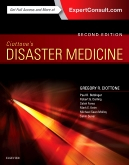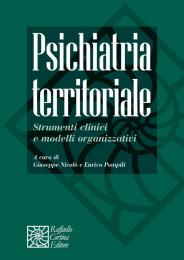Non ci sono recensioni
The most comprehensive resource of its kind, Ciottone’s Disaster Medicine, 2nd Edition, thoroughly covers isolated domestic events as well as global disasters and humanitarian crises. Dr. Gregory Ciottone and more than 200 worldwide authorities share their knowledge and expertise on the preparation, assessment, and management of both natural and man-made disasters, including terrorist attacks and the threat of biological warfare. Part 1 offers an A-to-Z resource for every aspect of disaster medicine and management, while Part 2 features an exhaustive compilation of every conceivable disaster event, organized to facilitate quick reference in a real-time setting.
Features:
- Quickly grasp key concepts, including identification of risks, organizational preparedness, equipment planning, disaster education and training, and more advanced concepts such as disaster risk reduction, tactical EMS, hazard vulnerability analysis, impact of disaster on children, and more.
- Understand the chemical and biologic weapons known to exist today, as well as how to best manage possible future events and scenarios for which there is no precedent.
New To This Edition:
- Be prepared for man-made disasters with new sections that include Topics Unique to Terrorist Events and High-Threat Disaster Response and Operational Medicine (covering tactical and military medicine).
- Get a concise overview of lessons learned by the responders to recent disasters such as the earthquake in Haiti, Hurricane Sandy, the 2014 Ebola outbreak, and active shooter events like Sandy Hook, CT and Aurora, CO.
- Learn about the latest technologies such as the use of social media in disaster response and mobile disaster applications.
- Ensure that everyone on your team is up-to-date with timely topics, thanks to new chapters on disaster nursing, crisis leadership, medical simulation in disaster preparedness, disaster and climate change, and the role of non-governmental agencies (NGOs) in disaster response - a critical topic for those responding to humanitarian needs overseas.
- Expert Consult eBook version included with purchase. This enhanced eBook experience allows you to search all of the text, figures, and references from the book on a variety of devices.
Table Of Contents:
1. Introduction to Disaster Medicine
Section 1: Introduction
2. Public Health and Disasters
3. The Role of Emergency Medical Services (EMS) in Disaster Management and Preparedness
4. Role of Emergency Medicine in Disaster Management
5. Disaster Nursing
6. The Role of Hospitals in Disaster
7. Complex Emergencies
8. Disaster and Climate Change
9. Children and Disaster
10. Psychological Impact of Disaster on Displaced Populations and Refugees of Multiple Traumas
11. Ethical Issues in Disaster Medicine
12. Issues of Liability in Emergency Response
Section 2: Domestic and International Resources
13. Disaster Response in the United States
14. Disaster Response in Europe
15. Local Disaster Response
16. State Disaster Response: Systems and Programs
17. Selected Federal Disaster Response Agencies and Capabilities
18. Global Disaster Response
19. Non-Governmental Organizations in Disaster Medicine
20. Disaster and Emergency Management Programs
Section 3: Pre-Event Topics
21. Emergency Department Design
22. Community Hazard Vulnerability Assessment
23. Health Care Facility Hazard and Vulnerability Analysis
24. Public Information Management
25. Informatics and Telecommunications in Disaster
26. Medical Simulation in Disaster Preparedness
27. Disaster Mitigation
28. Disaster Risk Management
29. Vaccines
30. Occupational Medicine: An Asset in Time of Crisis
31. Worker Health and Safety in Disaster Response
32. Disaster Preparedness
33. Policy Issues in Disaster Preparedness and Response
34. Mutual Aid
35. Patient Surge
Section 4: Event-Response Topics
36. Accidental versus Intentional Event
37. Crisis Leadership in Public Health Emergencies
38. The Incident Command System
39. Scene Safety and Situational Awareness in Disaster Response
40. Needs Assessment
41. Operations and Logistics
42. Disaster Communications
43. Mobile Disaster Applications
44. The Role of Social Media in Disasters
45. Volunteers and Donations
46. Personal Protective Equipment
47. Role of Bystanders in Disasters
48. Surveillance
49. Geographic Information Systems in Crises
50. Management of Mass Fatalities
51. Disaster Management of Animals
Section 5: Mechanical Operations in Disasters
52. Urban Search and Rescue
53. Medical Care in Remote Areas
54. Triage
55. Patient Tracking Systems in Disasters
56. Infectious Disease in a Disaster Zone
57. Pharmaceuticals and Medical Equipment in Disasters
Section 6: Post-Event Topics
58. Displaced Populations
59. Rehabilitation and Reconstruction
60. Disaster Education and Research
61. Practical Applications of Disaster Epidemiology
62. Measures of Effectiveness in Disaster Management
Section 7: Topics Unique to Terrorist Events and High-Threat Disaster Response
63. Lessons Learned as a Result of Terrorist Attacks
64. The Psychology of Terrorism
65. Thinking Outside the Box: Health Service Support Considerations in the Era of Asymmetrical Threats
66. Integrated Response to Domestic Terrorism
67. Multimodality, Layered Attack
68. Active Shooter Response
69. Hostage Taking
70. Civil Unrest and Rioting
71. Introduction to Explosions and Blasts
72. Suicide Bomber
73. Improvised Explosive Devices
74. Vehicle Borne Improvised Devices
75. Conventional Explosions at a Mass Gathering
76. Nuclear Disaster Management
77. Dirty Bomb (Radiologic Dispersal Device)
78. General Approach to Chemical Attack
79. Biologic Attack
80. Future Biologic and Chemical Weapons
81. Directed-Energy Weapons
82. Chemical, Biologic, Radiological, and Nuclear Quarantine
83. Chemical Decontamination
84. Radiation Decontamination
Section 8: Operational Medicine
85. Military Lessons Learned for Disaster Response
86. Integration of Law Enforcement and Military Resources with Emergency Response to a Terroist Incident
87. Tactical EMS
88. Medical Beyond The Barricade
89. Operational Rescue
90. Operations Security, Site Security and Incident Response
91. Medical Intelligence
92. Preventative Medicine for Responders in High Threat Environments
Section 9: Natural Disasters
93. Introduction to Natural Disasters
94. Hurricanes, Cyclones, and Typhoons
95. Earthquake
96. Tornado
97. Flood
98. Tsunami
99. Heat Wave
100. Winter Storm
101. Volcanic Eruption
102. Famine
103. Landslides
104. Avalanche
Section 10: Nuclear/Radiation Events
105. Introduction to Nuclear and Radiologic Disasters
106. Nuclear Detonation
107. Radiation Accident - Isolated Exposure
108. Radiation Accident - Dispersed Exposure
109. Nuclear Power Plant Meltdown
Section 11: Chemical Events
110. Introduction to Chemical Disasters
111. Industrial Chemical Disasters
112. Nerve Agent Mass Casualty Incidents
113. Vesicant Agent Attack
114. Respiratory Agent Mass Casualty Incident (Toxic Inhalational Injury)
115. Cyanide Attack
116. Antimuscarinic Agent Attack
117. Mass Casualty Incidents from LSD, Other Indoles, and Phenylethylamine Derivative
118. Opoid Agent Attack
119. Hydrofluoric Acid Mass Casualty Incident
120. Mass Casualties from Riot-Control Agents
121. Cholinergic Agent Attack (Nicotine, Epibatidine, and Anatoxin-a)
122. Anesthetic-Agent
Mass casualty Incident
Section 12: Biologic Events: Introduction
123. Introduction to Biologic Agents and Pandemics
Section 12: Biologic Events, Part 1: Bacterial Agents
124. Bacillus Anthracis (Anthrax) Attack
125. Yersinia Pestis (Plague) Attack
126. Francisella Tularensis (Tularemia) Attack
127. Brucella Species (Brucellosis) Attack
128. Coxiella burnetii (Q Fever) Attack
129. Rickettsia prowazekii Attack (Typhus Fever)
130. Orientia tsutsugamushi (Scrub Typhus) Attack
131. Rickettsia rickettsii (Rocky Mountain Spotted Fever) Attack
132. Vibrio cholarae (Cholera) Attack
133. Shigella dysenteriae (Shigellosis) Attack
134. Salmonella Species (Salmonellosis) Attack
135. Salmonella typhi (Typhoid Fever) Attack
136. Burkholderia mallei (Glanders) Attack
137. Burkholderia pseudomallei (Melioidosis) Attack
138. Chlamydophila psittaci (Psittacosis) Attack
139. Escherichia coli O157:H7 (Enterohemorrhagic E. Coli) Attack
Section 12: Biologic Events, Part 2: Viral Agents
140. Viral Encephalitis (Alphavirus) Attack
141. Tick-Borne Encephalitis Virus Attack
142. Viral Hemorrhagic Fever Virus Attack - Arenaviruses
143. Viral Hemorrhagic Fever Attack - Bunyavirus
144. Viral Hemorrhagic Fever Attack - Filo Viruses
145. Viral Hemorrhagic Fever Attack - Flaviviruses
146. Chikungunya Virus Attack
147. Variola Major Virus (Smallpox) Attack
148. Influenza Virus Attack
149. Monkeypox Attack
150. Hantavirus Pulmonary Syndrome Attack
151. Henipahvirus Attack: Hendra Virus and Nipah Viruses
152. SARS-CoV Attack (Severe Acute Respiratory Syndrome)
Section 12: Biologic Agents, Part 3: Toxins
153. Staphylococcal Enterotoxin B Attack
154. Clostridium botulinum Toxin (Botulism) Attack
155. Clostridium perfringens Toxin (Epsilon Toxin) Attack
156. Marine Toxin Attack
157. T-2 Toxin (Trichothecene Mycotoxins) Attack
158. Ricin Toxin from Ricinus communis (Castor Beans) Attack
159. Aflatoxin (Aspergillus Species) Attack
Section 12, Part 4: Other Biologic Agents
160. Coccidioides immitis (Coccidioidomycosis) Attack
161. Histoplasma capsulatum (Histoplamosis) Attack
162. Cryptosporidium parvum (Cryptosporidiosis) Attack
Section 13: Events Resulting in Blast Injuries
163. Explosions: Conventional
164. Explosions: Fireworks
165. Rocket-Propelled Grenade Attack
166. Conventional Explosion at a Hospital
167. Conventional Explosion in a High-Rise Building
168. Conventional Explosion at a Nuclear Power Plant
169. Tunnel Explosion
170. Liquified Natural Gas Explosion
171. Liquified Natural Gas Tanker Truck Explosion
172. Petroleum Distillation/Processing Facility Explosion
Section 14: Events Resulting in Burn Injuries
173. Introduction to Fires and Burns
174. Structure Fires
175. Wilderness and Forest Fire
176. Tunnel Fire
Section 15: Events Resulting in Ballistic Injuries
177. Gunshot Attack: Mass Casualties
178. Sniper Attack
179. Grenade and Pipe Bomb Injuries
Section 16: Events Resulting in Structural Collapse/Crashing/Crushing
180. Introduction to Structural Collapse (Crush Injury and Crush Syndrome)
181. Train Derailment
182. Subway Derailment
183. Bus Accident
184. Aircraft Crash Preparedness and Response
185. Air Show Disaster
186. Asteroid, Meteoroid, and Spacecraft Reentry Accidents
187. Building Collapse
188. Bridge Collapse
189. Human Stampede
190. Mining Accident
191. Submarine or Surface Vessel Accident
Section 17: Other Events/Combination Events
192. Aircraft Hijacking
193. Aircraft Crash into a High-Rise Building
194. Airliner Crash into a Nuclear Power Plant
195. Explosion at a Nuclear Waste Storage Facility
196. Maritime Disasters
197. Cruise Ship Infectious Disease Outbreak
198. Massive Power System Failures
199. Hospital Power Outage
200. Intentional Contamination of Water Supplies
201. Food Supply Contamination
202. Mass Gatherings
203. Ecological Terrorism
204. Computer and Electronic Terrorism and EMS
205. VIP Care




